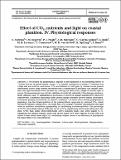Por favor, use este identificador para citar o enlazar a este item:
http://hdl.handle.net/10261/320450COMPARTIR / EXPORTAR:
 SHARE SHARE
 CORE
BASE CORE
BASE
|
|
| Visualizar otros formatos: MARC | Dublin Core | RDF | ORE | MODS | METS | DIDL | DATACITE | |

| Título: | Effect of CO2, nutrients and light on coastal plankton IV: Physiological Responses |
Autor: | Sobrino, C.; Segovia, M.; Neale, P.J.; Mercado-Carmona, Jesús Mariano; García-Gómez, Candela; Kulk, G.; Lorenzo, M. Rosario; Camarena, Teresa; van de Poll, Williem; Spilling, K. | Palabras clave: | Medio Marino Centro Oceanográfico de Málaga |
Fecha de publicación: | nov-2014 | Citación: | Auqatic Biology, 22. 2014: 77-93 | Resumen: | We studied the physiological response of phytoplankton to the interacting effects of 3 factors affected by global climate change: CO2, nutrient loading and irradiance. Treatments had a high and low level for each factor: CO2 was bubbled at 1000 ppm by volume versus present atmo spheric values; high nutrient treatments had a combination of inorganic and organic nutrients; and light treatments were obtained by covering the tanks with a single or double layer of screen. We measured esterase activity, oxidative stress (ROS), cell death, DNA damage, photosynthetic efficiency and 14C assimilation as particulate or dissolved organic material (POC and DOC respectively). Conditions simulating future global change scenarios showed similar chlorophyllnormalized primary productivity as present conditions. The main effect driving phytoplankton physiology was the downregulation of the photosynthetic apparatus by elevated CO2, which decreased esterase activity, ROS, cell death and DNA damage. Nutrient concentration and light acted as additional modulators, upregulating or contributing to downregulation. The percentage of DO14C extracellular release (PER) was low (0 to 27%), significantly lower under ultraviolet radiation (UVR) than under photosynthetically active radiation (PAR), and acted mainly to reequilibrate the internal balance when cells grown under UVR were exposed to PAR. PER was almost 3 times lower under high CO2, confirming a higher resource use efficiency of phytoplankton under future CO2 concentrations. | URI: | http://hdl.handle.net/10261/320450 | DOI: | 10.3354/ab00590 |
| Aparece en las colecciones: | (IEO) Artículos |
Ficheros en este ítem:
| Fichero | Descripción | Tamaño | Formato | |
|---|---|---|---|---|
| b022p077 gapsobrino.pdf | 399,75 kB | Adobe PDF |  Visualizar/Abrir |
CORE Recommender
SCOPUSTM
Citations
27
checked on 02-may-2024
WEB OF SCIENCETM
Citations
25
checked on 26-feb-2024
Page view(s)
26
checked on 10-may-2024
Download(s)
15
checked on 10-may-2024
Google ScholarTM
Check
Altmetric
Altmetric
NOTA: Los ítems de Digital.CSIC están protegidos por copyright, con todos los derechos reservados, a menos que se indique lo contrario.
